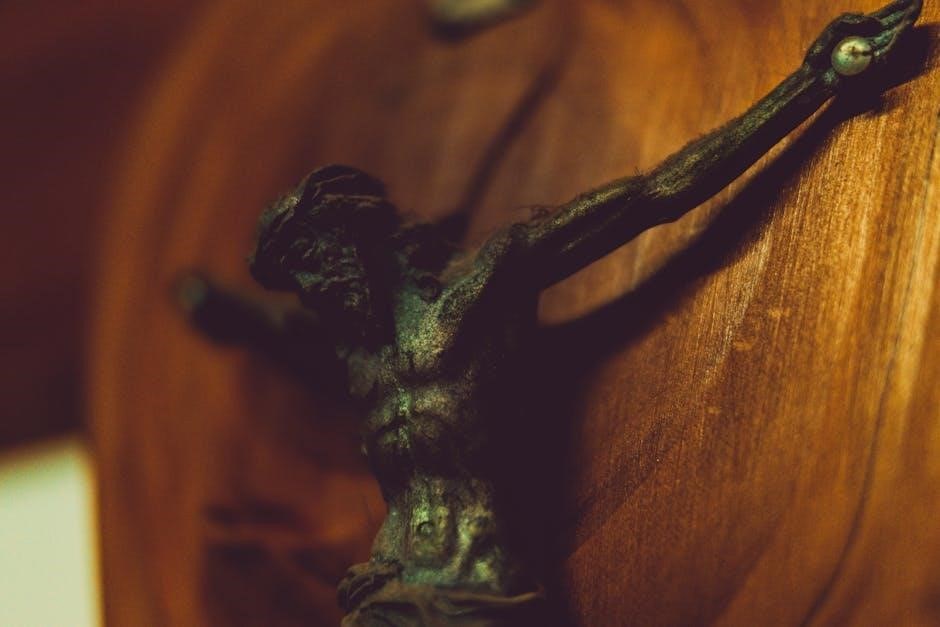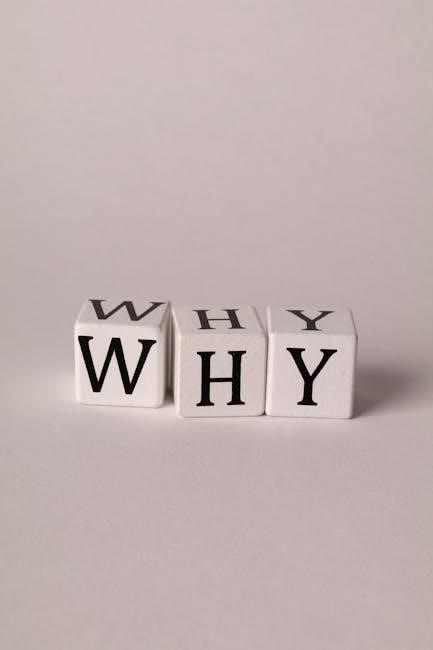This article provides an in-depth exploration of Lord of the Flies Chapter 4‚ offering study questions‚ answers‚ and analysis to enhance understanding of key events‚ themes‚ and character development.
Overview of the Article
This article delves into the key aspects of Lord of the Flies Chapter 4‚ providing a comprehensive analysis of events‚ themes‚ and character dynamics. It explores the escalating tensions among the boys‚ the destruction of sandcastles by Maurice and Roger‚ and Jack’s transformation with face paint. The chapter’s significance in highlighting power struggles‚ the loss of innocence‚ and the role of fear is examined. Additionally‚ it offers study questions‚ answers‚ and resources‚ including PDF guides and quizzes‚ to aid in understanding the chapter’s deeper meanings and symbolism. This overview sets the stage for a detailed exploration of the chapter’s content and themes.
Importance of Chapter 4 in Lord of the Flies
Chapter 4 of Lord of the Flies is pivotal as it marks a turning point in the boys’ descent into savagery. The destruction of the sandcastles‚ Jack’s face paint‚ and the signal fire’s extinction symbolize the erosion of civilization. This chapter highlights the power struggle between Ralph and Jack‚ foreshadowing future conflicts. It also explores themes of innocence‚ fear‚ and the effects of isolation. The events in Chapter 4 are crucial for understanding the novel’s central message about human nature and societal breakdown. This chapter sets the stage for the escalating chaos and moral decay in subsequent chapters.

Key Events in Chapter 4
The chapter begins with the Littluns building sandcastles‚ showcasing their innocence. Maurice and Roger destroy the castles‚ symbolizing rising aggression. Jack paints his face‚ embracing savagery. The signal fire burns out‚ highlighting negligence. Ralph confronts the hunters‚ revealing leadership struggles. These events underscore the boys’ gradual descent into chaos.
The Opening Scene: The Littluns and Their Sandcastles
The chapter opens with the Littluns‚ including Henry and Percival‚ building intricate sandcastles on the beach. This peaceful scene highlights their innocence and creativity. The sandcastles symbolize their attempt to recreate order and civilization in their new environment. However‚ this tranquility is short-lived‚ as Maurice and Roger‚ influenced by their growing savagery‚ deliberately destroy the castles. This act not only reflects their disregard for others’ efforts but also foreshadows the escalating violence and chaos on the island. The destruction of the sandcastles marks a turning point‚ signaling the erosion of innocence and the rise of primitive instincts among the boys.
The Destruction of the Sandcastles by Maurice and Roger
The destruction of the sandcastles by Maurice and Roger marks a pivotal moment in Chapter 4‚ showcasing their growing disregard for others’ efforts. The Littluns‚ who had meticulously built the castles‚ are left disheartened and powerless. This act of vandalism reflects the boys’ regression into savagery‚ as they prioritize amusement over cooperation. Maurice and Roger’s actions‚ influenced by their alliance with Jack’s tribe‚ highlight the spreading chaos and lack of accountability. The destruction symbolizes the unraveling of innocence and the erosion of civilized behavior‚ setting the stage for further conflict and moral decay among the group.

Jacks Use of Face Paint and Its Significance
Jack’s decision to paint his face in Chapter 4 symbolizes his embrace of savagery and his growing detachment from civilized norms. The paint acts as a mask‚ allowing Jack to shed his identity as a choirboy and adopt a more primal‚ fearsome persona. This transformation underscores his desire for power and control‚ as he seeks to intimidate others and assert dominance. The face paint also represents Jack’s psychological shift‚ as he becomes more aggressive and less constrained by moral boundaries. This act marks a turning point in his character‚ foreshadowing his eventual descent into full-blown savagery and his rivalry with Ralph.
The Signal Fire Goes Out
The signal fire‚ a crucial symbol of hope and rescue‚ goes out in Chapter 4 due to the hunters’ negligence. Jack and his group‚ prioritizing hunting over their responsibilities‚ fail to maintain the fire. This oversight occurs during a crucial moment when a ship passes by‚ making the boys’ rescue unlikely. The extinction of the fire symbolizes the group’s declining organization and responsibility‚ as well as their increasing focus on primal desires over civilized priorities. Ralph’s frustration highlights the growing divide between him and Jack‚ further emphasizing the erosion of their initial unity and purpose. This event foreshadows deeper chaos.
Ralphs Leadership and the Hunters’ Negligence
Ralph’s leadership is tested as the hunters‚ led by Jack‚ neglect their duties. The signal fire‚ a symbol of hope‚ goes out due to their carelessness‚ highlighting Ralph’s struggle to maintain order. His frustration grows as the group’s priorities shift from rescue to savagery. Ralph’s inability to control the hunters underscores the weakening of his authority and the rising tension between him and Jack. This negligence not only jeopardizes their chances of rescue but also reveals the boys’ gradual descent into chaos‚ as their primal instincts overshadow their civilized intentions. Ralph’s leadership is further strained by the hunters’ lack of responsibility.

Themes in Chapter 4
The chapter explores themes of power struggles‚ loss of innocence‚ and fear‚ highlighting the boys’ descent into savagery as civilization fades.
Power Dynamics and the Struggle for Leadership
In Chapter 4‚ the power struggle between Ralph and Jack intensifies‚ reflecting their conflicting priorities. Ralph focuses on maintaining order and achieving rescue‚ while Jack craves dominance and hunting glory. The chapter highlights how Jack’s desire for control undermines Ralph’s authority‚ leading to a shift in the group’s dynamics. The face-painted Jack embodies a primal transformation‚ symbolizing his rejection of civility. This struggle illustrates the broader theme of civilization versus savagery‚ as fear and the pursuit of power drive the boys’ actions. The leadership conflict foreshadows further divisions‚ revealing how unchecked ambition can dismantle societal structures.
The Loss of Innocence and Civilization
Chapter 4 marks a significant decline in the boys’ civilized behavior‚ as their primal instincts begin to dominate. Jack’s face paint symbolizes his embrace of savagery‚ while the destruction of the sandcastles by Maurice and Roger reflects a growing disregard for innocence and creativity. The signal fire’s extinction mirrors the group’s moral decay‚ as their focus shifts from rescue to immediate gratification. Ralph’s struggling leadership highlights the erosion of order‚ while Jack’s dominance signifies the rise of a more primal‚ fear-driven society. This chapter underscores the boys’ gradual abandonment of civility and their descent into chaos.
The Role of Fear and Superstition
Fear and superstition dominate Chapter 4‚ as the boys’ primal anxieties surface. The legend of the “beast” creates widespread terror‚ influencing their decisions and behavior. Jack manipulates this fear to gain power‚ using it to justify his aggressive hunting tactics. The fear of the unknown becomes a unifying force‚ yet it also divides the group as paranoia grows. The boys’ inability to distinguish reality from superstition highlights their vulnerability. This fear-driven mindset accelerates their descent into savagery‚ as rationality gives way to irrational beliefs and actions. The chapter vividly portrays how fear can shape behavior and destabilize order. Superstition thus becomes a catalyst for chaos.

Study Questions for Chapter 4
This section provides a comprehensive set of questions to test understanding of key events‚ themes‚ and character dynamics in Chapter 4.

Comprehension Questions
How is the setting depicted at the beginning of Chapter 4? What is the daily life like on the island at this point in the novel?
Why does the signal fire go out‚ and what are the consequences?
How does Jack’s behavior change after he paints his face?
What does Simon do for Piggy‚ and what does this reveal about his character?
These questions assess understanding of key events‚ character actions‚ and their implications‚ helping readers engage deeply with the chapter.
How is the setting depicted at the beginning of Chapter 4? What is the daily life like on the island at this point in the novel?
The setting at the beginning of Chapter 4 is peaceful‚ with the littluns building sandcastles on the beach. The island’s beauty contrasts with the growing tension among the boys. Daily life is marked by a struggle to maintain order‚ as the group faces challenges like hunger and fear. The boys’ priorities shift‚ with hunting and power struggles overshadowing their initial focus on survival. This reflects their gradual descent into chaos‚ as their civilized behavior begins to erode. The chapter highlights the fragile balance between their innocent play and the looming savagery.
Why does the signal fire go out‚ and what are the consequences?
The signal fire goes out because the hunters‚ led by Jack‚ fail to maintain it while hunting. This negligence leads to a missed opportunity for rescue when a passing ship does not see the signal. The fire’s extinction symbolizes the group’s declining priorities and the erosion of their civilized instincts. The consequences include the loss of hope‚ increased fear‚ and the further fracturing of the group’s unity. This event marks a turning point in the novel‚ as the boys’ savagery begins to overshadow their efforts to maintain order and survive. The fire’s absence also heightens the sense of isolation.
How does Jacks behavior change after he paints his face?
After painting his face‚ Jack’s behavior becomes more aggressive and authoritarian. The mask gives him a sense of anonymity and power‚ allowing him to shed his former identity and embrace his primal instincts. He becomes more confident in asserting his dominance‚ showing contempt for Ralph’s leadership. Jack’s actions reflect his growing desire for control and savagery‚ as he prioritizes hunting over the group’s well-being. This transformation marks a significant shift in his character‚ highlighting his descent into barbarism and his growing rivalry with Ralph. The face paint symbolizes his liberation from societal norms and his embrace of a more savage identity.
What does Simon do for Piggy‚ and what does this reveal about his character?
Simon shows kindness to Piggy by finding him food‚ such as meat‚ which the other boys often withhold. This act highlights Simon’s compassionate and selfless nature‚ as he goes out of his way to help someone in need. Unlike the others‚ Simon treats Piggy with respect and dignity‚ demonstrating his moral integrity. This reveals that Simon is empathetic‚ thoughtful‚ and genuinely cares for others‚ even when it’s not socially advantageous. His actions contrast sharply with the growing savagery and indifference among the other boys‚ showcasing his unique character and moral strength.
Analytical Questions
- How does William Golding use the destruction of the sandcastles to symbolize the boys’ descent into savagery?
- What does the signal fire represent‚ and how does its extinction affect the group’s morale?
- How does Jacks desire for power and control manifest in this chapter?
These questions encourage readers to think critically about the chapter’s themes‚ such as the loss of innocence and the struggle for leadership. They also prompt an analysis of how symbols‚ like the signal fire‚ reflect the boys’ societal breakdown. By exploring these points‚ students can deepen their understanding of Golding’s message about human nature and civilization.
How does William Golding use the destruction of the sandcastles to symbolize the boys’ descent into savagery?
In Chapter 4 of Lord of the Flies‚ the sandcastles built by the Littluns symbolize order‚ creativity‚ and the remnants of civilization. Golding uses their destruction by Maurice and Roger to illustrate the erosion of innocence and the rise of primal instincts. The act of destroying something innocent and harmless reflects the boys’ growing disregard for rules and their embrace of chaos. This event mirrors the broader theme of civilization giving way to savagery‚ as the boys’ behavior becomes more aggressive and less governed by moral constraints. The destruction of the sandcastles serves as a visual representation of their internal regression.
What does the signal fire represent‚ and how does its extinction affect the group’s morale?
The signal fire symbolizes hope‚ rescue‚ and the boys’ connection to civilization. It is a shared goal that unites them and represents their commitment to being saved. When the fire goes out due to the hunters’ negligence‚ it leads to a loss of morale and unity. The extinction of the fire mirrors the group’s internal collapse‚ as their primal instincts overshadow their civilized intentions. The fire’s absence fosters fear‚ despair‚ and division‚ highlighting the boys’ regression into savagery and their diminishing hope of rescue. This event underscores the conflict between Ralph’s focus on rescue and Jack’s pursuit of power.
How does Jacks desire for power and control manifest in this chapter?
Jack’s desire for power and control becomes evident as he prioritizes hunting over maintaining the signal fire‚ showcasing his shifting priorities. He embraces savagery by painting his face‚ which symbolizes his transformation and desire to break free from societal norms. Jack’s disregard for Ralph’s leadership and the group’s safety highlights his growing ambition. His actions reflect a need for dominance‚ as he increasingly challenges Ralph’s authority and focuses on immediate gratification through hunting. This chapter marks the beginning of Jack’s transition from a team player to a rival leader‚ driven by his hunger for power and control.
Discussion Questions
How does the destruction of the sandcastles reflect the broader themes of chaos and disorder in the novel?
What role does the signal fire play in maintaining hope and unity among the boys?
How does Simon’s quiet strength influence the group‚ and what does his actions reveal about his character?
In what ways does Piggy’s rationality contrast with the growing savagery of the others?
How does the chapter portray the tension between individual desires and the common good?
What does the boys’ fear of the “beast” reveal about their psychological state?
How does Golding use the island’s environment to mirror the boys’ internal struggles?
What does the mask symbolize in the context of Jacks transformation?
What does the mask symbolize in the context of Jack’s transformation?
The mask symbolizes Jack’s escape from accountability and his embrace of savagery. By hiding his face‚ Jack sheds his civilized identity and inhibitions‚ allowing him to act on primal instincts. The mask becomes a tool for intimidation and control‚ reflecting his growing desire for power. It also represents his disconnection from moral responsibility and his descent into barbarism. The mask transforms Jack into a figure of fear‚ marking his transition from a choirboy to ahunt-oriented leader. This transformation highlights the novel’s theme of the erosion of innocence.
How does the chapter highlight the conflict between Ralphs leadership and Jacks authority?
How does the chapter highlight the conflict between Ralph’s leadership and Jack’s authority?
The chapter underscores the growing tension between Ralph’s democratic leadership and Jack’s authoritarianism. Ralph prioritizes the signal fire and shelter‚ symbols of civilization‚ while Jack focuses on hunting‚ embodying primal instincts. Their conflict escalates when Jack’s hunters neglect the fire‚ allowing it to go out. This negligence frustrates Ralph‚ highlighting their differing values. Jack’s defiance and desire for control clash with Ralph’s attempts to maintain order‚ showcasing a power struggle that reflects the broader theme of civilization versus savagery. Their confrontation foreshadows the eventual breakdown of their alliance and the rise of chaos on the island.
What role does fear play in shaping the boys’ actions and decisions?
Fear significantly influences the boys’ actions and decisions in Chapter 4. The persistent belief in the “beast” creates a climate of anxiety‚ driving the boys to prioritize hunting and safety over civility. Jack uses fear to assert dominance‚ painting his face to intimidate others and hide his true identity. Ralph‚ meanwhile‚ fears the loss of their civilized ways‚ struggling to maintain order. Fear of the unknown and fear of each other escalate tensions‚ leading to reckless behavior‚ such as the destruction of the sandcastles. This fear-driven mentality accelerates their descent into savagery‚ as primal instincts override rational decision-making.
Chapter 4 explores the boys’ descent into savagery‚ with Jack’s face paint symbolizing his transformation. The signal fire’s extinction highlights their neglect‚ while Ralph’s leadership is challenged.

Key Plot Points
- The chapter begins with the littluns constructing intricate sandcastles‚ showcasing their creativity and innocence.
- Maurice and Roger maliciously destroy the sandcastles‚ reflecting their growing savagery and disregard for others.
- Jack paints his face‚ symbolizing his embrace of primal instincts and his transformation into a hunter.
- The signal fire‚ a crucial tool for rescue‚ is allowed to go out due to the hunters’ negligence.
- Ralph confronts Jack about the extinguished fire‚ highlighting their escalating conflict and differing priorities.
- Simon assists Piggy by carrying his conch shell‚ demonstrating his kindness and loyalty.
- The group’s discipline and hope for rescue begin to unravel‚ foreshadowing further chaos.
Character Development in Chapter 4
In Chapter 4‚ Jack’s transformation becomes more pronounced as he embraces savagery‚ revealed by his face paint and aggressive hunting mindset. Ralph’s leadership is challenged‚ showing his growing frustration and conflict with Jack. Simon’s kindness shines through as he helps Piggy‚ highlighting his compassionate nature. Maurice and Roger display cruelty‚ destroying sandcastles‚ indicating their moral decline. The chapter underscores the boys’ internal struggle between civilization and primal instincts‚ with some clinging to order while others surrender to chaos; These developments deepen the themes of power‚ fear‚ and the erosion of innocence.
Symbolism and Foreshadowing
In Chapter 4‚ the signal fire symbolizes hope and rescue‚ while its extinction foreshadows the group’s decline into savagery. The conch shell‚ once a symbol of democracy‚ begins to lose its power‚ reflecting the erosion of order. Jack’s face paint symbolizes his transformation into a primal hunter‚ foreshadowing his complete embrace of savagery. The destruction of the sandcastles by Maurice and Roger signifies the collapse of innocence and civilization. The fear of the beast grows‚ foreshadowing future chaos. These symbols and events highlight the boys’ descent into darkness‚ warning of the consequences of unchecked human nature.

Analysis of Chapter 4
Chapter 4 explores the boys’ moral decay‚ highlighting Jack’s primal transformation and Ralph’s failing leadership. The signal fire’s extinction and sandcastle destruction symbolize lost hope and innocence‚ foreshadowing chaos.
Symbolism: The Signal Fire and the Conch Shell
The signal fire symbolizes hope‚ rescue‚ and the boys’ connection to civilization. Its extinction in Chapter 4 represents a loss of priorities and the group’s descent into savagery. The conch shell‚ once a symbol of order and democracy‚ begins to lose its power‚ reflecting the erosion of their moral framework. Both symbols highlight the tension between civilization and primal instincts‚ as the boys’ behavior becomes increasingly governed by fear and power struggles rather than reason and cooperation. These symbols underscore Golding’s exploration of humanity’s inherent darkness when societal structures crumble.
Character Analysis: Jack‚ Ralph‚ and Simon
In Chapter 4‚ Jack’s desire for power intensifies‚ as he becomes more aggressive and dismissive of Ralph’s leadership. His face paint symbolizes his transformation into a primal hunter‚ marking his detachment from civility. Ralph‚ though still striving to maintain order‚ begins to show signs of frustration and weakness‚ struggling to uphold the group’s priorities. Simon‚ on the other hand‚ emerges as the voice of reason‚ displaying compassion and insight‚ particularly in his quiet support for Piggy. His actions highlight his gentle nature and lonely understanding of the island’s true reality‚ contrasting sharply with the growing savagery around him.
Themes: Civilization vs. Savagery
In Chapter 4‚ the theme of civilization vs. savagery is prominent as the boys’ behavior becomes increasingly primal. The destruction of the sandcastles by Maurice and Roger symbolizes the erosion of innocence and order. Jack’s face paint represents his embrace of savagery and desire for power‚ while Ralph’s focus on the signal fire highlights his commitment to civilization. The extinction of the fire underscores the group’s neglect of civilized priorities‚ foreshadowing their descent into chaos. This chapter starkly contrasts the boys’ fading moral constraints with their growing primal instincts‚ illustrating Golding’s exploration of human nature’s darker side.

PDF Resources for Chapter 4
Download PDF study guides for detailed summaries‚ analysis‚ and answers to Chapter 4 questions. Access quizzes‚ worksheets‚ and expert insights to enhance understanding and preparation.
Popular Study Guides and Worksheets
Find comprehensive study guides and worksheets for Chapter 4 of Lord of the Flies in PDF format. These resources include detailed question banks‚ character analyses‚ and chapter summaries.
They often feature critical thinking exercises‚ vocabulary lists‚ and essay prompts. Many guides provide answers to common questions‚ making them ideal for self-study or classroom use.
Popular platforms offer downloadable PDFs with structured lessons and activities. These tools are designed to deepen understanding of themes like power dynamics and the loss of innocence.
Worksheets may include scene analyses‚ quote explanations‚ and creative tasks. They are perfect for reinforcing key concepts and preparing for exams or discussions.
Using these resources can help students engage more effectively with the chapter’s events and themes‚ ensuring a thorough grasp of Golding’s narrative.
Quiz Questions and Answer Keys
Enhance your understanding of Chapter 4 with downloadable PDFs containing quiz questions and answer keys. These resources feature multiple-choice questions‚ true/false statements‚ and short-answer prompts.
Questions focus on key events‚ character motivations‚ and thematic elements. Answer keys provide detailed explanations‚ ensuring clarity and accuracy for students and educators alike.

Many PDFs include essay prompts and discussion points‚ allowing for deeper analysis of the chapter. These tools are invaluable for exam preparation or classroom activities.
Utilize these quizzes to assess comprehension and reinforce learning. They cover topics like the destruction of sandcastles‚ Jack’s transformation‚ and the signal fire’s significance.
Access these resources to engage effectively with the chapter and master its critical themes and events.
How to Use PDF Resources Effectively
To maximize learning potential‚ start by skimming the PDF to identify key sections like chapter summaries or practice questions. Set specific study goals‚ such as mastering themes or analyzing characters. Use highlighters or annotations to mark important points. Practice answering quiz questions to test comprehension. Review answer keys carefully‚ focusing on explanations to clarify misunderstandings. Incorporate discussion prompts into group studies to foster deeper insights. Regularly revisit the material to reinforce retention. By following these steps‚ you can efficiently utilize PDF resources to enhance understanding and prepare thoroughly for assessments.
Final Thoughts on Chapter 4
Chapter 4 highlights the escalating tension between civilization and savagery‚ showcasing pivotal moments like the sandcastle destruction and Jack’s transformation‚ which foreshadow future conflicts.
Preparation for Future Chapters
Focus on the deepening rivalry between Ralph and Jack‚ the role of fear‚ and the moral decay of the group as the story progresses.
In Chapter 4 of Lord of the Flies‚ the boys’ behavior escalates towards chaos‚ revealing the fragile boundaries between civility and savagery. The destruction of the sandcastles by Maurice and Roger‚ Jack’s face paint symbolizing his transformation‚ and the signal fire’s extinction highlight the group’s moral decay. Ralph’s leadership weakens as fear and superstition dominate‚ foreshadowing darker events. The chapter underscores themes of power struggles‚ loss of innocence‚ and the dangers of unchecked human nature. These events set the stage for the boys’ further descent into savagery‚ making Chapter 4 a pivotal moment in the novel’s exploration of human behavior.
Chapter 4 lays the groundwork for the escalating tensions and conflicts in later chapters. The power struggle between Ralph and Jack intensifies‚ and the boys’ fear of the “beast” grows‚ setting the stage for further divisions. The destruction of the signal fire and the sandcastles symbolizes the erosion of hope and order. As the novel progresses‚ the themes of savagery‚ leadership‚ and morality will deepen. Understanding these developments in Chapter 4 is crucial for analyzing how the boys’ behavior evolves and how their actions lead to the tragic events of the novel. Study resources like PDF guides can aid deeper analysis.


